The Intel Broadwell-E Review: Core i7-6950X, i7-6900K, i7-6850K and i7-6800K Tested
by Ian Cutress on May 31, 2016 2:01 AM EST- Posted in
- CPUs
- Intel
- Enterprise
- Prosumer
- X99
- 14nm
- Broadwell-E
- HEDT
Professional Performance: Windows
Agisoft Photoscan – 2D to 3D Image Manipulation: link
Agisoft Photoscan creates 3D models from 2D images, a process which is very computationally expensive. The algorithm is split into four distinct phases, and different phases of the model reconstruction require either fast memory, fast IPC, more cores, or even OpenCL compute devices to hand. Agisoft supplied us with a special version of the software to script the process, where we take 50 images of a stately home and convert it into a medium quality model. This benchmark typically takes around 15-20 minutes on a high end PC on the CPU alone, with GPUs reducing the time.
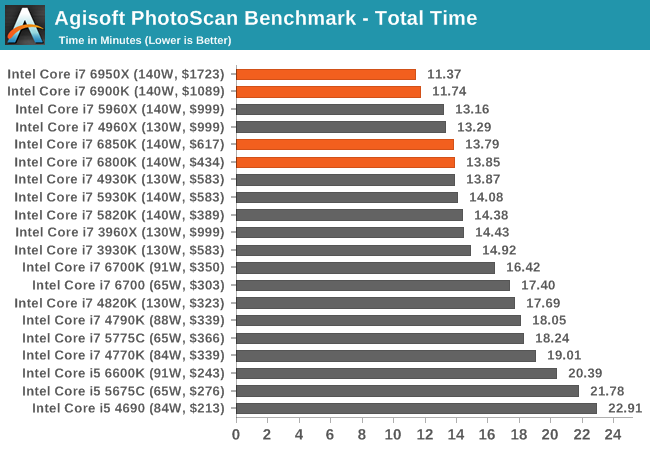
Cinebench R15
Cinebench is a benchmark based around Cinema 4D, and is fairly well known among enthusiasts for stressing the CPU for a provided workload. Results are given as a score, where higher is better.

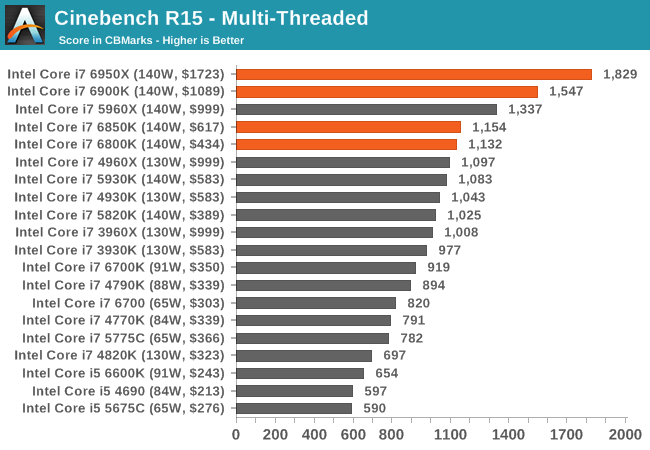
HandBrake v0.9.9: link
For HandBrake, we take two videos (a 2h20 640x266 DVD rip and a 10min double UHD 3840x4320 animation short) and convert them to x264 format in an MP4 container. Results are given in terms of the frames per second processed, and HandBrake uses as many threads as possible.
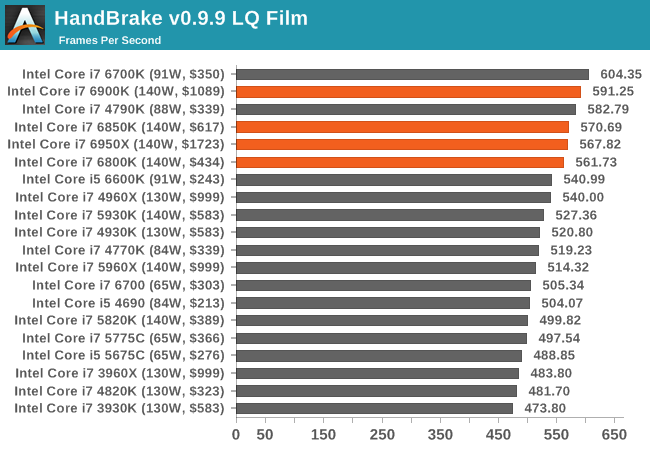
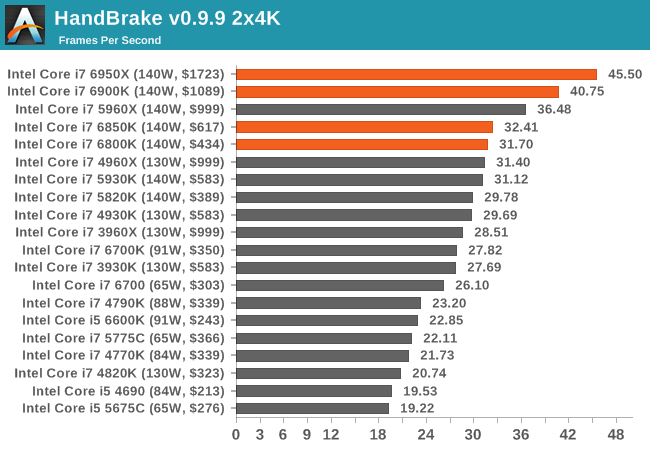
Hybrid x265
Hybrid is a new benchmark, where we take a 4K 1500 frame video and convert it into an x265 format without audio. Results are given in frames per second.
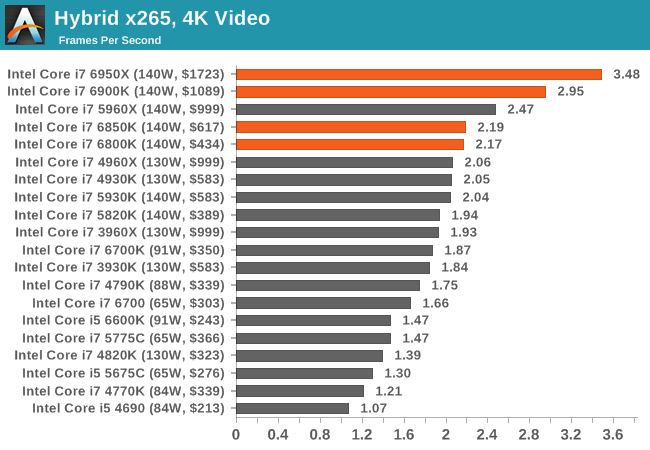










205 Comments
View All Comments
JimmiG - Tuesday, May 31, 2016 - link
What's worse than the price premium is that you're also paying for the previous generation architecture.I really don't see why anyone would want one of those CPUs. For gaming and most typical applications, the mainstream models are actually faster because of their more modern architecture and higher clock speeds. If you're a professional user, you should really be looking at Xeons rather than these server rejects.
K_Space - Tuesday, May 31, 2016 - link
Exactly. I think that's the whole point: Intel realizes that -realistically- little profit will be made from these B-Es given the little incremental increase in performance so why not use them as an advert for the Xeons (which they have aggressively been marketing for HEDT not just servers over the last few month). Anyone considering these will consider the Xeons now.Ratman6161 - Tuesday, May 31, 2016 - link
There are a few benchmarks where they do make sense, if and only if you are doing that particular task for your job i.e. an environment where time is money. For the rest of us, if I need to do a video conversion of some kind its relatively rare and I can always start it before I go to bed.retrospooty - Tuesday, May 31, 2016 - link
People belittle AMD because even though Intel has dramatically slowed down the pursuit of speed, AMD still cant catch up. It's actually worse than that though. If AMD were competitive at all in the past decade Intel would still be perusing speed and would be further ahead. Its a double edged sword sort of thing.Flunk - Tuesday, May 31, 2016 - link
Yes, Intel has slowed down for AMD to catch up before. Cough, Pentium 4.retrospooty - Tuesday, May 31, 2016 - link
Yup... and back then AMD took advantage of it. I was the happy owner of a Thunderbird, then an Athlon, then an Athlon X2... Then Intel woke up and AMD went to sleep. For the past decade AMD has been too far behind to even matter. In the desktop CPU space there is Intel and then ... no-one.Flunk - Tuesday, May 31, 2016 - link
You're right, it's totally Intel's fault. They could launch a line of high-end consumer chips that cost the same as the current i5/i7 line but had 2-3X as many cores but no iGPU. They'd cost Intel the same to fabricate. They're the only ones to blame for their slowing sales.khon - Tuesday, May 31, 2016 - link
I could see people buying the i7-6850K for gaming, 6 cores at decent speeds + 40 PCI-E lanes, and $600 is not that bad when consider that some people have $700 1080's in SLI.However, the i7-6900/6950 look like they are for professional users only.
RussianSensation - Tuesday, May 31, 2016 - link
40 PCI lanes are worthless when i7 6700K can reliably overclock to 4.7-4.8Ghz, and has extra PCIe 3.0 lanes off the chipset. The 6850K will be lucky to get 4.5Ghz, and still lose in 99% of gaming scenarios. Z170 PCIe lanes are sufficient for 1080 SLI and PCIe 3.0 x4 in RAID.6850K is the worst processor in the entire Broadwell-E line.
Impulses - Tuesday, May 31, 2016 - link
Well if you're about gaming only you might as well compare it with the 6600K... AFAIK HT doesn't do much for gaming does it? The 6800K isn't much better either when your can just save a few bucks with the 5820K.I feel like they could've earned some goodwill despite the high end price hikes by just putting out a single 68xx SKU for like $500, it'd still be a relative price hike for entry into HEDT but could be more easily seen as a good value.
Are the 6800K bad die harvests or something? Seems dumb to keep that artificial segmentation in place otherwise when HEDT is already pretty far removed from the mainstream platform.
When I chose the 6700K over the 5820K I thought it'd be the last quad core I'd buy, but at this pace (price hikes, HEDT lagging further behind, lower end SKU still lane limited) I don't know if that'll be true.